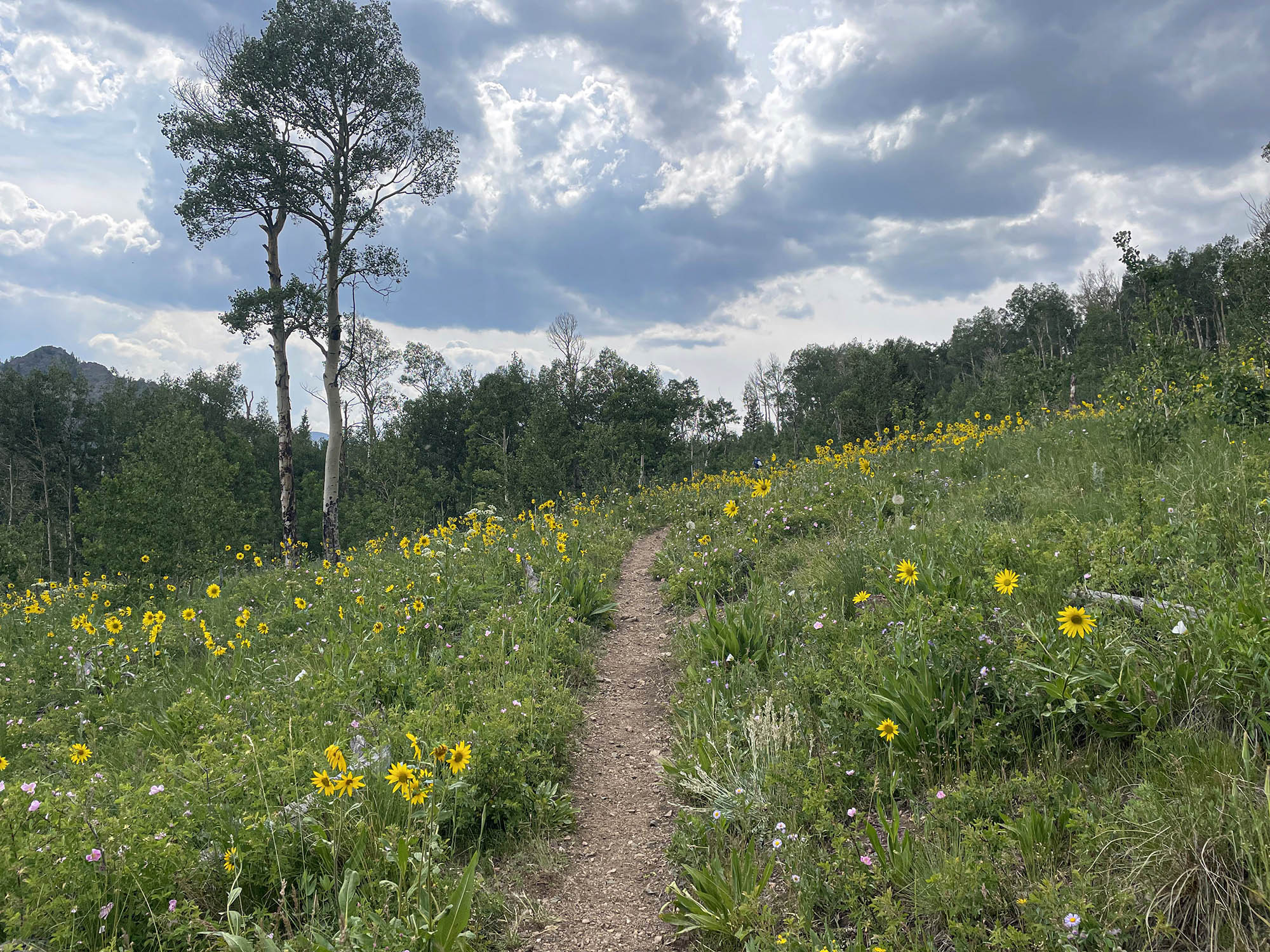What can you learn from a backpacking trip when everything goes wrong? If you’ve spent long enough in the outdoors (if you’re new to backpacking, check out our comprehensive guide!), you’re nearly guaranteed to have a story or two where things just didn’t go the way you imagined they would on your wilderness getaway. Some people like to call it “Type 2 Fun”, the kind that feels like an ordeal at the time but makes for a good story over beer long after you’ve recovered. Perhaps gear malfunctioned, or other hikers ruined the trip and made things uncomfortable, maybe it was an injury, or even a hungry bear that derailed your trip.
For Alissa, it was all of these. What started as a solo thru-hike of the Colorado Trail ended only eight days into the trip, leaving her with unforgettable memories – just not the kind she expected to make. After everything that happened, Alissa has a unique perspective on the courage to overcome unexpected trail challenges, and profound advice for herself and others after being humbled by the CT.
The Colorado Trail
The Colorado Trail is a long distance hiking, biking, and running trail stretching nearly 500 miles from the center of Colorado, in Denver all the way down to the southwest corner, in Durango.
Between Denver and Durango, hikers are both greeted and challenged by steep mountain passes exceeding 13,000ft in elevation and a whole lot of gorgeous wilderness; including deep creek crossings, mountain lions, bears, and …mosquitoes oh my! Hundreds of hikers looking to challenge themselves and experience the heart of Colorado set out to face these challenges and backpack these trails. In 2021, one of those hikers was Alissa.
Map created by Postholer.com
Alissa’s Hike
In July of 2021, Alissa began her thru-hike of the Colorado Trail, stepping into this vast expanse of rugged mountains and the challenges they carry. Alissa was no novice when it came to long distance backpacking and thru-hiking. Not only had Alissa grown up spending lots of time outside, just the year prior she had taken on California’s 211 mile John Muir Trail. The JMT traverses from Yosemite National Park to Mt. Whitney, the highest point in the contiguous 48. The John Muir Trail follows the crest of the Sierra Nevada range. Many of the challenges and hazards found on the John Muir Trail are similar to those found on the Colorado Trail. After her flawless thru-hike of the John Muir Trail, when she planned her Colorado Trail thru-hike, she felt confident to take it on solo with her husband and boys rooting her on from back home in California.
Day 1: July 15, 2021 – Bear Spray
The Ursus Americanus, or American Black Bear as we know it best, has a wide distribution across the state of Colorado with an estimated population of 17,000-20,000 bears. How much of the Colorado Trail is bear habitat? Nearly every inch. Traveling through subalpine forests and alpine meadows, the CT landscape is a bear paradise. When Alissa had begun to plan out her thru-hike and contemplate completing it solo, she asked for advice from the Women of the CT Facebook group. One suggestion that came up repeatedly for hiking as a solo female was to carry bear spray. The black bears found in Colorado are almost never predatory. However, from time to time bears can be surprised or act to defend their cubs. In recent years, more and more bears have become bold and aggressive toward hikers after accessing improperly stored food. When faced with a defensive or attacking bear, and clapping and shouting fails, no tool is better than bear spray.
Capsaicinoids, bear spray’s key ingredient, are the specific chemical compounds in chile peppers that result in the eye watering and scorching agony you may have experienced from eating a bit too much hot sauce. These compounds can be extracted from peppers and concentrated. This inferno level mixture is combined with other inert ingredients and gas propellants to create pepper spray. Bear spray takes the concept from pepper spray and supercharges it on steroids. In bear spray, the E.P.A allows up to a 65% greater concentration of capsaicinoids in the mixture, stronger propellants that can launch the mixture 20-30 feet, and larger volumes of mixture to envelop an entire bear in a cloud of temporarily agonizing eye and nose pain.
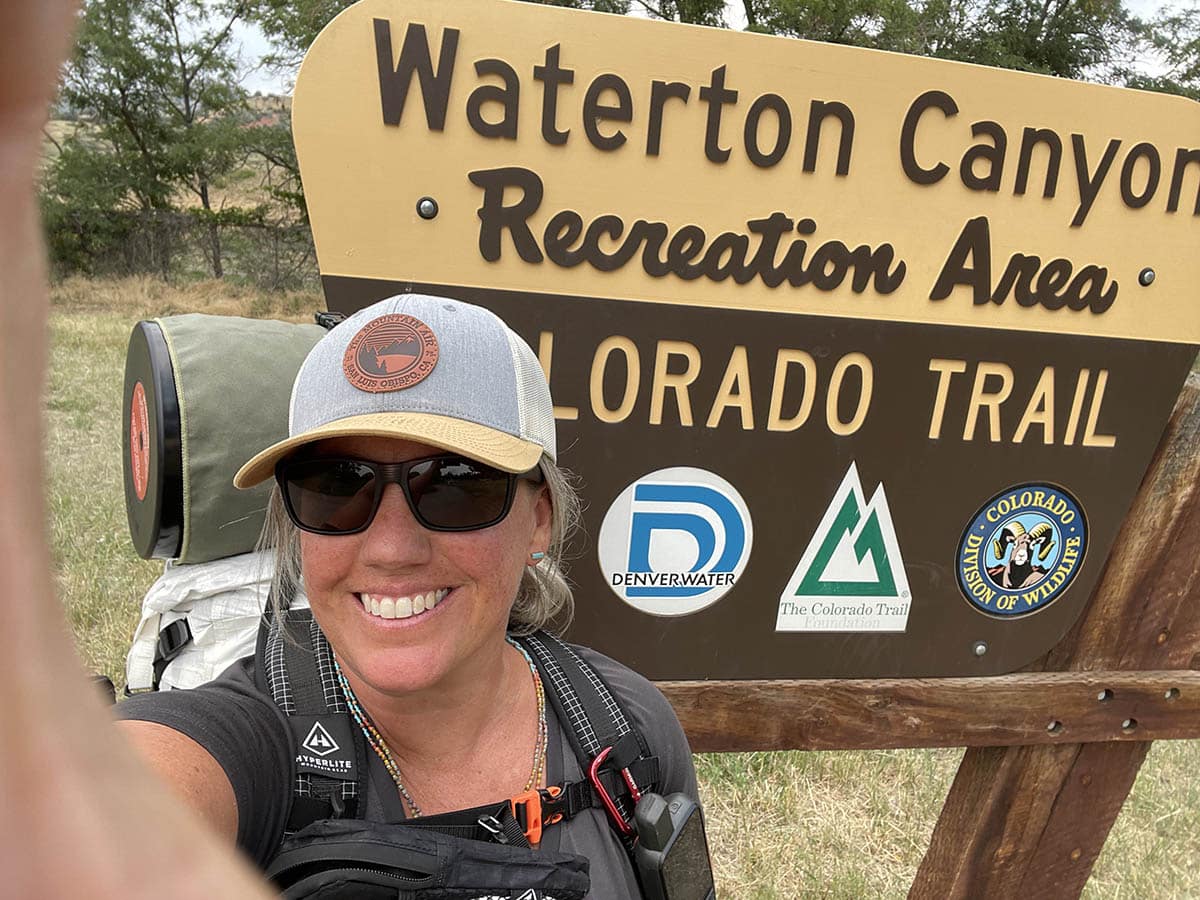
All this is great if you have a bear charging at you at up to 30 miles per hour. However, on day 1 in Waterton Canyon, Alissa did not have a bear charging at her. While hiking, her backpack was slowly rubbing on the safety cap of the bear spray. Mile by mile, the cap inched up and eventually fell off – all without Alissa noticing. When Alissa paused to take a break, and appreciate the progress she had made on the first day in this grand adventure, she sat down. This depressed the nozzle, shooting high pressure bear spray between her back and her backpack. This concentration of capsaicinoids physically burns the skin. Canada defines bear spray as a hazardous skin irritant. If working in direct contact with the substance a full body protection suit is required. Summary: this stuff is really potent and gnarly.
While most of us would quit right there and head back to Denver for a very long shower and fresh clothing, Alissa pushed forward. Her clothes burned. Her backpack burned. Everything burned. To make matters worse, the bear spray does not wash off easily at all. According to Alissa, everything burned for days. She got the feeling of what it’s like to be an errant bear sprayed with bear spray.
Day 2: July 16, 2021 – Communication
The other tool that Alissa carried into the backcountry was a Garmin inReach satellite communicator. While these communicators have changed the game for emergency communication with search and rescue, (and will play a key part in Alissa’s story), they receive less attention for how they let users communicate with family and friends. For Alissa, being able to send basic texts back and forth with her family was another key to her feeling comfortable with taking on this trip solo.
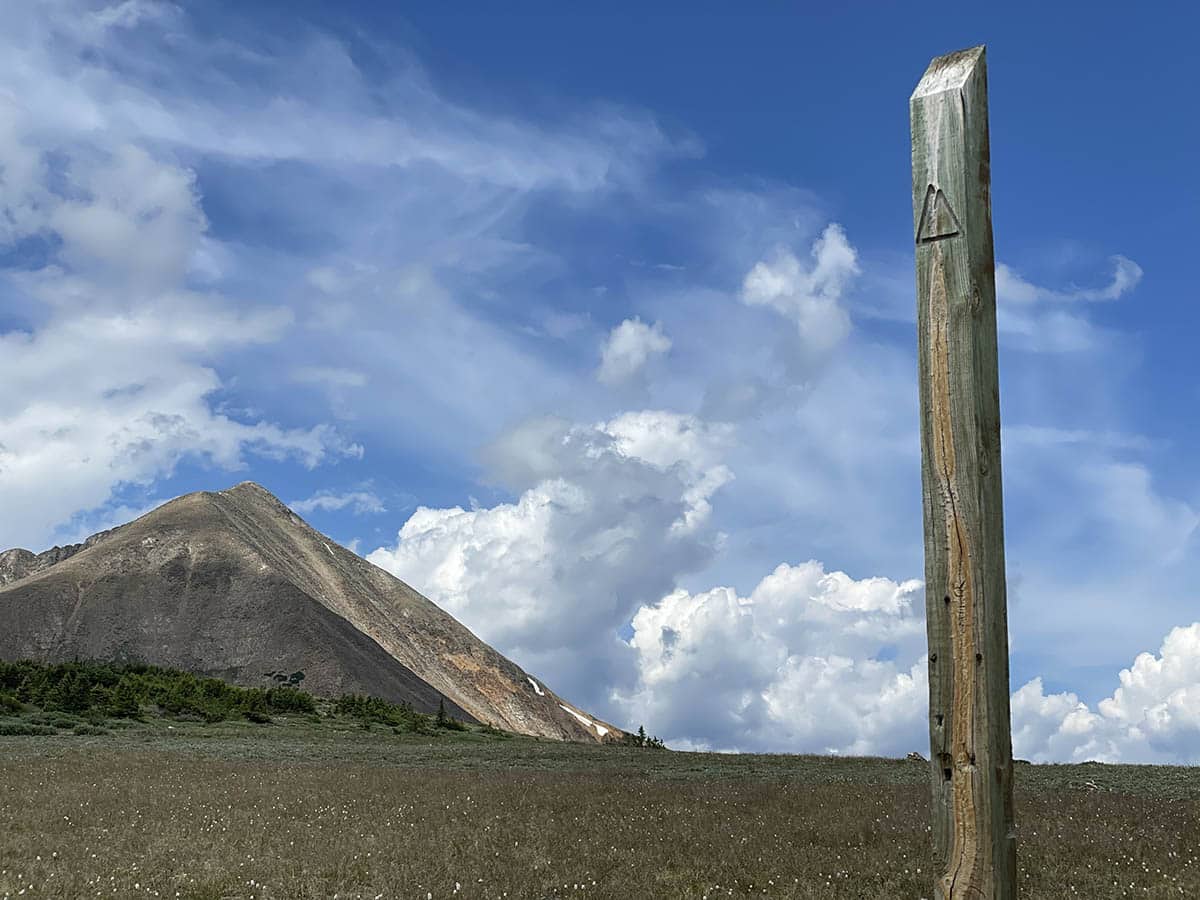
That all changed on day two when yet another extremely unlikely gear malfunction befell Alissa. The Garmin inReach went kaputz – it was a total lemon. It was not out of battery or broken by user error. While the device would later be covered under warranty, she had immediately lost all communication with her family as there is no cell service along nearly the entire Colorado Trail, including this section.
While not having a satellite communicator meant no lifeline in an emergency situation, it also meant an emotional toll without having the connection to her family that she was counting on. What would they start thinking if she didn’t communicate for days or weeks? She had a husband and sons back home waiting for her, and expecting her periodic communications. Within 48 hours of starting the hike, two unlikely events had already occurred. What could be next?
Day 3-5: July 17-19, 2021 – Creepy
The following day, Alissa found another hiker on the trail who had a two-way satellite communicator. Her family had been expecting a check-in and their worry was growing. Initially, Alissa was relieved to be able to borrow the communicator and let family know that she would not be checking in. However, she did not realize who might be listening to her conversation.
A different thru-hiker camping in the same area overheard her asking to borrow the satellite communicator and knew that Alissa was now more vulnerable without her communicator and extremely exhausted from the bear spray incident.
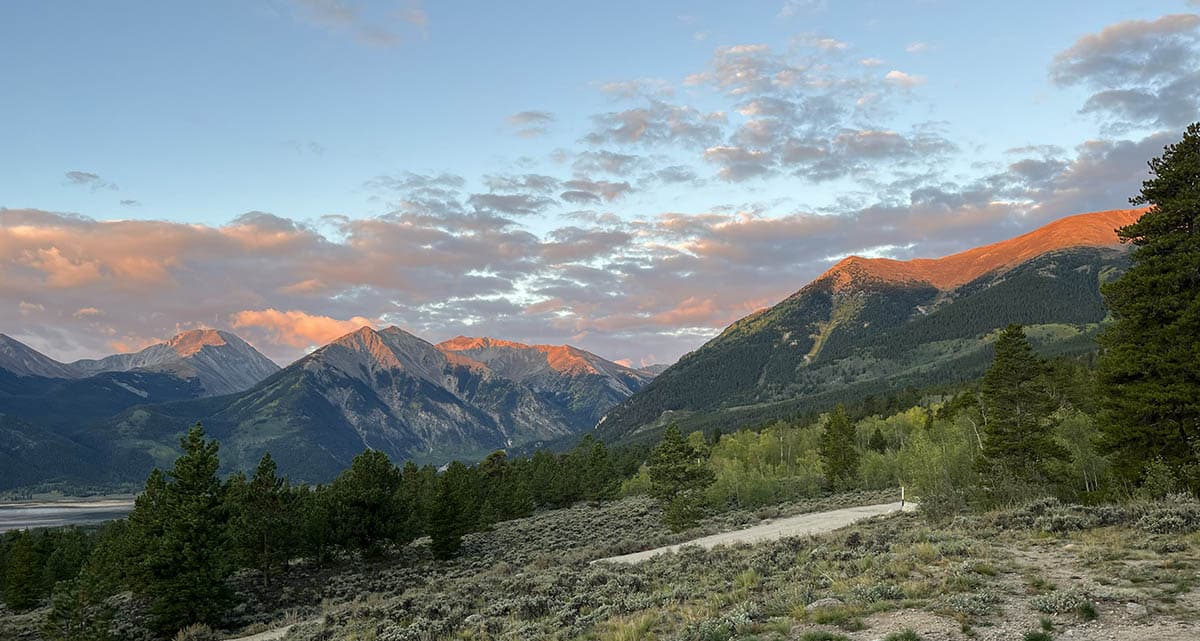
In the 2021 edition of the annual survey of Pacific Crest Trail Hikers, the Blog Halfway Anywhere reported that nearly 40% of female hikers on the trail experienced gender discrimination. There are countless anecdotes from every thru-hike under the sun of men not valuing or respecting women, creepy guys following women, and worse.
Alissa experienced this first hand. The thru-hiker who eavesdropped on Alissa talking about the satellite communicator failing began to follow Alissa. While some hikers simply speed ahead to shake people they are not jiving with, Alissa takes a measured and steady pace. This meant that she was always easy to find. Whether this guy was lonely and looking for a friend or had more sinister motives, Alissa was looking for a solo wilderness experience and did not consent to being followed by an odd stranger who would not stop saying things that made her uncomfortable. For the next several days, Alissa was unable to shake this creepy guy, which created psychological stress and soured the very experience she had come to enjoy.
Day 6-7: July 20-21, 2021 – Bear Canister
If you thought Alissa’s Colorado Trail experience was getting wild – buckle up. On the evening of July 20th, almost a week into the trail, Alissa camped at Jefferson Creek in Segment 6. Situated at just shy of 10,000 feet between Kenosha Pass and Breckenridge, Jefferson Creek is a babbling brook that cuts through pines, meadows, and groves of aspen trees. The combination of easy access and great views makes Jefferson Creek a heavily trafficked area on the Colorado Trail. What Alissa did not know was that a food conditioned and habituated bear also enjoyed that same creek. With hundreds of hikers, many of whom do not properly store food in bear resistant containers, this black bear had learned where to look for easy calories and how to pull down food hangs and shred Ursacks.
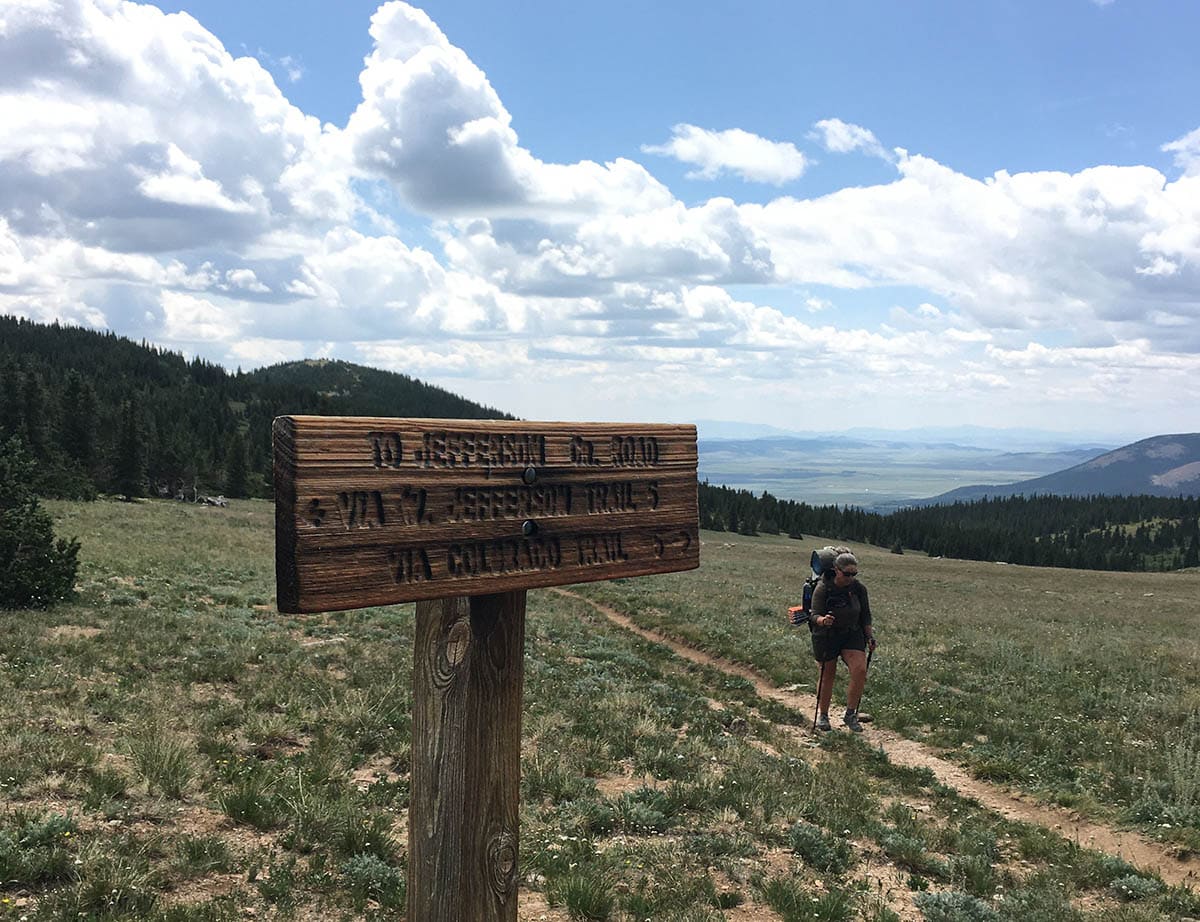
Unaware of this bear, Alissa cozied up in her tent on the 6th night – skin still burning from the bear spray, and emotionally exhausted from her satellite communicator failing and the creepy guy who had followed her for several days. A few hours later, she woke up to the sound of the bear investigating her tent and ready to tear it open if there was food inside.
The bear sniffed my tent, right at my head, which is why I woke up. He sounded like my dog sniffing me but 1,000 times bigger. I sat up instantly in terror because I knew exactly what he was, and then the next thing I heard was this massive commotion trying to get that BearVault open. The noise was terrifying!
-Alissa
Three Colorado Trail thru-hikers in the busy area had stored their food near each other down by the creek. Alissa and one other hiker had BearVault bear canisters and the third hiker unfortunately chose to carry an Ursack. Over the next eternity, the bear laid into the stored food.
Alissa described the situation, “You should have heard the noise and commotion he made trying to get into it. It was dark, so we couldn’t see his body, just his eyes glowing from the reflection of our flashlights. He was really pouncing on it.”
One positive thing about camping in a busy area that night was that Alissa was able to round up an impromptu possy of hikers to scare off the bear. Finally, with the bear bandit successfully banished, the scene was surveyed. The two BearVault canisters had deep scratches in the lids but were intact and operational. The Ursack did not fare so well: it was crushed into a pulp with the stove mangled into bits and mixed with sunscreen, food, bug spray, and everything else in the “bear resistant” bag. When dawn came, the long sleepless night spent praying that the bear would not return finally ended. The hiker who had his Ursack crushed had to retreat back to the highway several miles away and try to thumb a ride back to Denver now that his gear and supplies were ruined.
Alissa also did something critical – she asked for help. Even though she had set out to do this trail solo she realized she needed to lean on the hiker community for help. She told a group of two couples about the creepy guy following her, while also marshaling their help to clean up the trash strewn everywhere from the bear’s recent raids. They hoped to change the outcome for the next hikers to camp in this bear’s territory – a shout out to doing the right thing for Leave No Trace!
If Alissa did not have a bear canister, her Colorado Trail thru-hike would have ended right then and there. All her food, toiletries, and other items were safe and sound in the canister. Most importantly, since she had not slept with her food, she was physically unscathed and did not have to duel with this habituated bear – which certainly would not have ended well.
Day 8: July 22, 2021 – Injury
Despite Alissa’s BearVault solidly defending her food, she still found herself exhausted after this marathon of a week. Not only had she faced the challenge of hiking through rugged wilderness; she had also been injured for days by bear spray, stressed by her loss of communication, pestered and threatened by a creepy guy, and spent a sleepless night listening to a bear attack food stashes and sniff her tent. While hiking on a seemingly smooth section of trail, Alissa collapsed. On the way down, she gashed her knee on a rock, slicing open her skin. The same two couples who had helped her after the bear encounter the previous day and protected her from the creepy guy, heard her calling for help. To her relief, they came running back up the trail to help her and administer first aid. With blood spewing everywhere from the injury, they made the decision to call search and rescue with one of the couples’ Garmin inReach devices.
The Summit county sheriff’s office was able to reach Alissa on a fire road and picked her up to head to the ER for stitches. On the way down the mountain, the sheriff’s deputy served as both rescuer and a good listener. Alissa broke down crying while sharing the magnitude of everything that had gone wrong in her week of hiking. For an experienced hiker wanting to explore one of the most beautiful long trails in the world, Alissa’s experience on the Colorado Trail was truly a series of too many unfortunate events.
After a few stitches to patch up the knee, Alissa checked into a hotel and slept for two days to recover and decompress after all that had happened. From there, she flew home to her family in California to continue to recover and plan her comeback on the Colorado Trail.

The Aftermath
Alissa had plenty of unplanned rest time to put her thoughts together following her ealy departure from the trail. Although frustrated, she was able to really gain perspective:
“Backpacking is a lot like life. It often doesn’t go as planned: sometimes we need to ask for help, sometimes it requires putting the needs of others before ourselves when things get hard, and we have less control over our circumstances than we realize. Courage comes in forms previously unknown. Community is important, family is even more important – and I don’t know how people go through life without prayer and trust in God. I was humbled on this trip.”
-Alissa
After recovering, Alissa took the time to warn other hikers traveling through the Jefferson Creek area about the dangers by bravely posting her ordeal in a Facebook group. She also reached out to BearVault to swap her damaged lid for a new one, and shared the details of her harrowing tale.
Alissa encourages everyone to carry a bear canister when backpacking the Colorado Trail, whether you are solo or in a group. Even if you are willing to risk your food, you have a responsibility to the wildlife and the safety of hikers around you. Previous hikers in this area had slept with their food, hung it, and put it in Ursacks. Each of these food storage methods taught the bear that there were easy calories any time it visited Jefferson Creek. Once a bear is food conditioned due to the choices of hikers, it puts future hikers like Alissa in danger, even when her food was properly stored in a hard sided canister. Furthermore, the actions of the hikers who improperly stored the food likely directly contributed to the death of the bear. While we do not know what happened to this specific bear, Colorado land managers are forced to kill an average of 275 food conditioned and habituated bears a year that pose a threat to people.
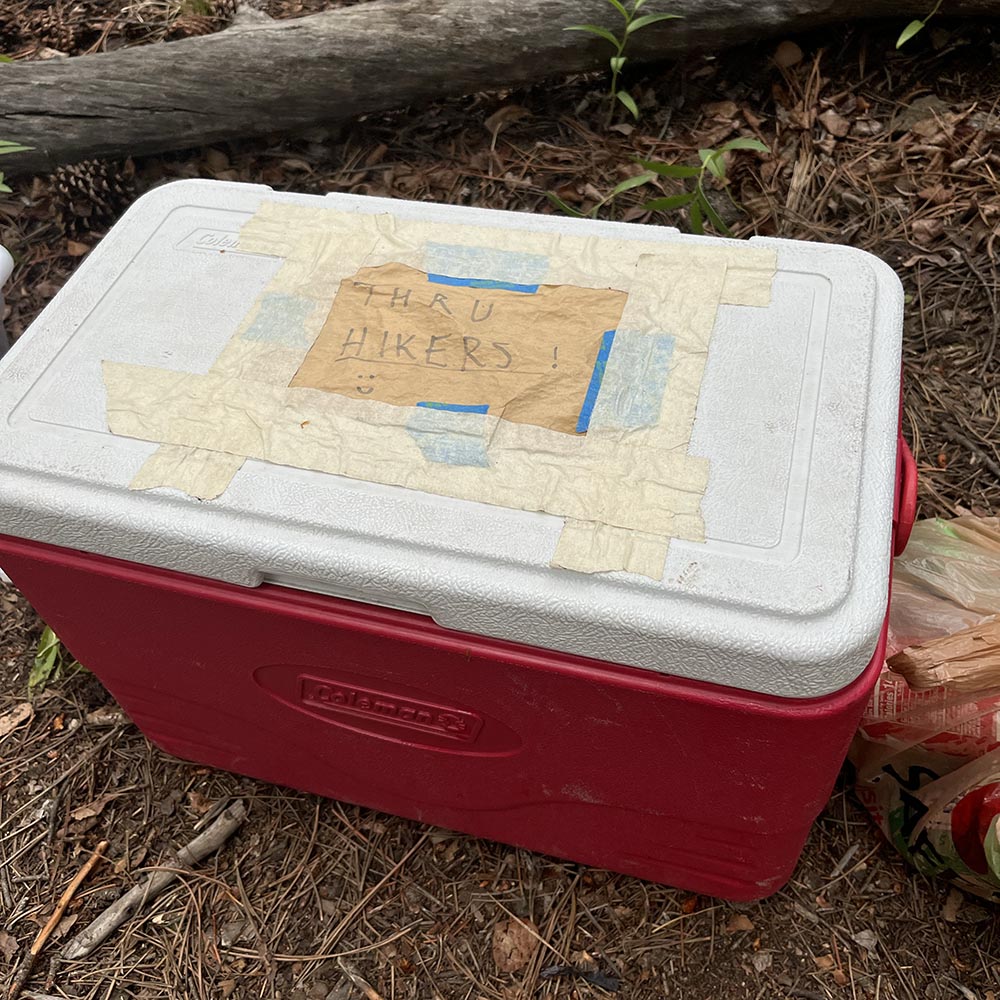
Every hiker, solo or not, has a responsibility to the hikers around them on the trail. This can take many forms, big and small, such as sharing a Garmin inReach, administering first aid, scaring off a bear, properly storing food in a bear canister, or just not being a creepy hiker on the trail.
As hiking continues to grow in popularity, our responsibility to the places we love and our fellow hikers only grows. What can you do to be a good steward?
Oh, and Alissa is not done with the Colorado Trail. She will be back to tackle it again in the company of her family, with her husband and boys, very soon.
About the Colorado Trail
The history of the Colorado Trail begins at the creation of the earth, but to spare you the details, we will skip ahead to just a little while ago, in geologic time. 70 to 80 million years ago the Fallaron tectonic plate was sliding down under the North American plate. Yes, think Dinosaurs. In a period known as the Laramide Orogeny, or mountain building event, the region we know today as the Colorado plateau was thrust upwards. Then, through a series of ice ages known as the Pleistocene Epoch, the Rocky Mountains were sculpted into the mountains we know and recognize today through the forces of glacial abrasion and plucking.
Still, millennia before hikers like Alissa would backpack through these mountains, indigenous peoples such as the Ute, Cheyenne, Arapaho, and other tribes knew these landscapes and relied on the geology, flora, and fauna to enable their cultures to flourish.
In the late 19th century and early 20th century, the United States Government began to establish the United States Forest Service to evaluate, and with presidential approval, designate parcels of land as National Forests or “Forest Reserves.” In the early years, the focus was on extractive resources, such as timber harvesting. With a cool climate, high elevations, and copious winter snowfall, 23 million acres, or nearly one third of the state of Colorado, is covered in pines, firs, aspens and other forest flora. This abundance of trees meant that many national forests were established in the state. Over the years, the scope of the Forest Service expanded to encompass more than logging, seeking to also to protect wildlife, native species, and recreation within the national forests.
After years of dreaming, a forester by the name of Bill Lucas began to plan the vision for a trail winding through these great forests – the “Rocky Mountain Trail.” Through the 1970s and early 1980s, the vision for the trail gained support and funding. However, the process was not rapid, and the early enthusiasm and funding dwindled throughout the late seventies. Some visionaries, like Gudy Gaskill, kept the hope alive and wrangled volunteers each summer to construct the trail at an incremental pace. A 1984 piece from the Denver Post described it as “a trail to nowhere”, and trail building progress completely stalled. When all hope seemed lost, the Denver Post article caught the attention of Governor Dick Lamm, who got behind the project and rallied support. Two years later, 1,000 volunteers and 46 trail crews were building the trail at a rate never seen before. By late 1987, the trail was linked together, creating a monumental 485 mile continuous foot, bike, and horse trail.
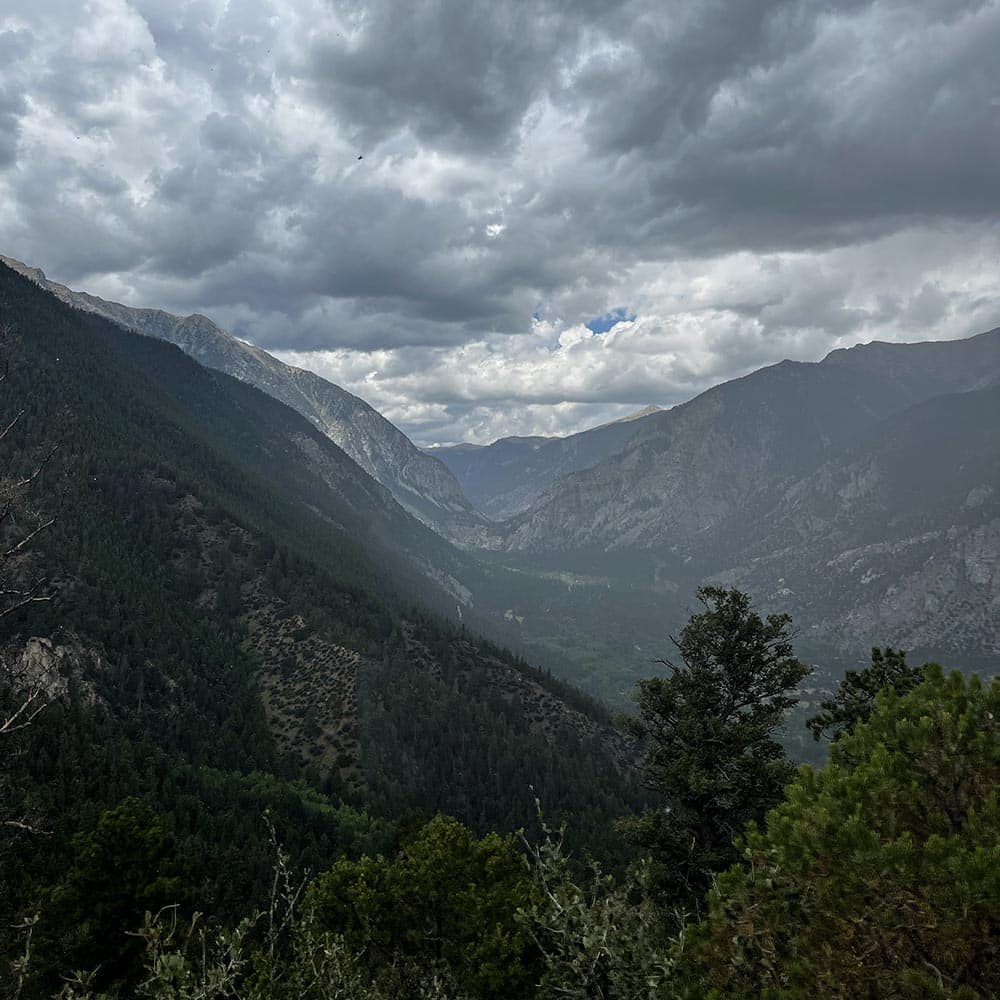
The Colorado Trail begins at Waterton Canyon, just on the SW outskirts of Denver. The trail quickly winds up in elevation passing near the Lost Creek Wilderness before crossing highway 285 at the aspen-filled Kenosha Pass at 10,000 feet. From there, the trail completes its foray through the Front Range Mountains when it drops down into the Blue River Valley near Breckenridge. After skirting the Ten Mile Range, the trail plunges south along the towering 14ers of the Sawatch and Collegiate peaks. Next, the trail jogs west, tracing the great divide through the Gunnison National Forest. Eventually, the trail enters the wild San Juan Mountains. Miles later, the Continental Divide goes south, whereas the Colorado Trail ventures further into the heart of the southern San Juan Mountains. Finally, the trail follows ridges slowly down into the mountain town of Durango. This end point sits in the far southwestern corner of Colorado, nearly 500 trail miles, and over 200 miles as the crow flies from where it began in Denver.
Today the Colorado Trail is cared for in partnership with the United States Forest Service and the Colorado Trail Foundation. Every summer the foundation rallies volunteers to adopt trail sections and keep up with erosion, water drainage, fallen trees, and signage. If you want to steward the Colorado Trail and maintain it as the finest long trail you can get together friends and family to adopt an entire section.
Alternatively, for 2023 the foundation has identified 17 hot spot locations where trail crew volunteers are needed for 1-7 day projects. There are opportunities for every level of commitment. (There are even women-only crews to avoid creepy guys like Alissa had to deal with) Furthermore, the Colorado Trail Foundation needs financial support to continue to look after the trail. Consider giving to support this amazing place. Lastly, the foundation maintains a website with a wealth of information on melt-out dates, planning guides, and even the official guidebook. This is a great place to begin planning your trip!
Sunflowers cover image courtesy of Alissa

